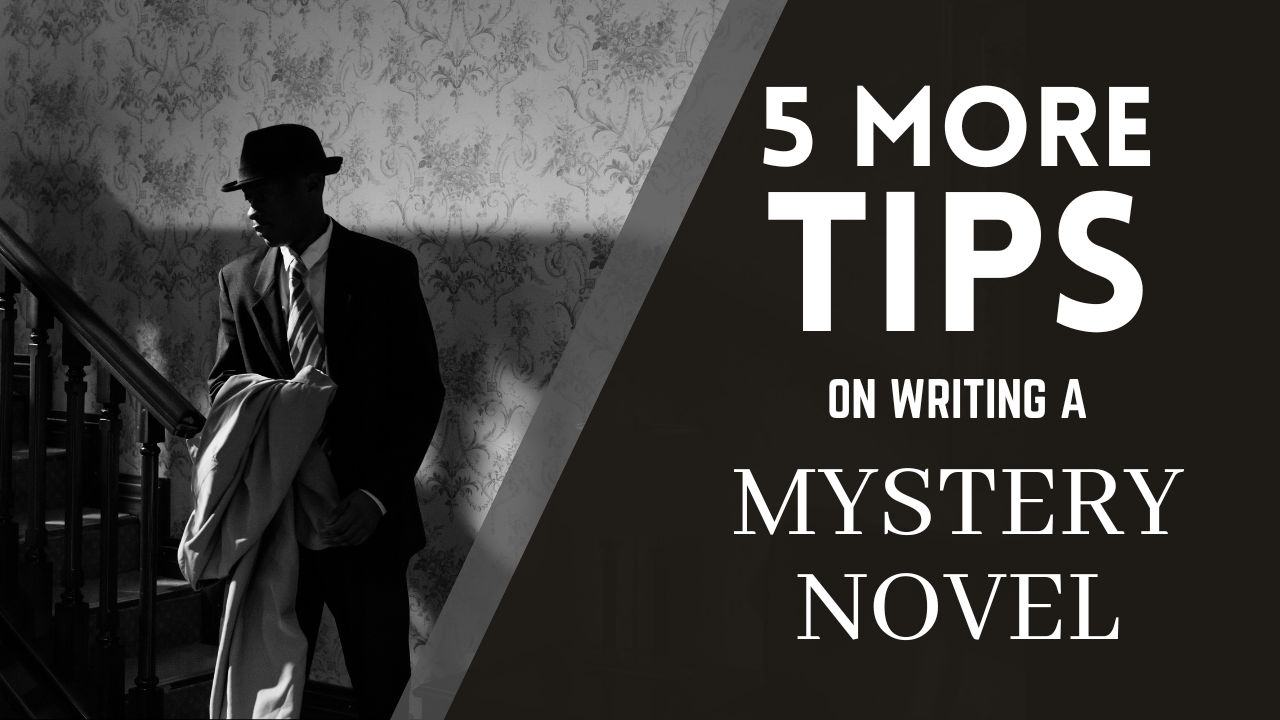Latest Writing Video! |
|
Mystery novels blew up in the 70s, later becoming one of the most stable and popular genres in the writing world. Many readers love mystery stories, be it a focus on a cliche detective in a noir setting or a high schooler solving their local murder mystery. The only problem is that writing mystery novels can be very challenging. Here are 5 more mystery tips to make your mystery a must-read! Pin for Later!1. Create Intrigue, Raise QuestionsThe core nature of a great detective is curiosity. When the detective notices something odd, something out of place, questions begin to form in their mind and they want answers. Sometimes they get their answers by asking others, other times they use their brilliance and reasoning to find their answer. Many times their curiosity gets them into danger! The reader works the same way. A good mystery novel will create intrigue. You can arouse a reader’s curiosity the same way you can with the main character. Present them with something out of place. Subtly focus on it, and let the reader already start making assumptions. While the gears in their head start turning, they unconsciously flip pages to seek an answer. A tactic of many authors is to grab the reader with an exciting opening. One that makes them feel some emotion, be it excitement or horror. As a mystery novelist, your goal is to intrigue. You can do this by presenting a clue… The white corner of a note stuck out from a book on the table. …an oddity… The bullet came from the victim's gun, but the gun showed no sign of being fired. …or even a conclusion that you can reverse engineer. It was the girl from the flower shop who stole it. Each line is an example of what a mystery reader expects from a mystery story. Yet, by opening with some cut-and-dry lines that require further explanation, that require a story, you gain their interest. Something that is very important if you don’t have an established series or character. The reader doesn’t know anything about the people in your book, they have no attachment to anything, but you can quickly create a temporary attachment by raising questions. By the time they have some answers, they have formed some real attachments, either to the characters or to the story. 2. Be Misleading, but LogicalThat brings me to the point about misleading your reader. I talked about red herrings and great methods for misleading a reader in my previous post on mysteries, which you can check out here, but I didn’t emphasize the importance of being logical. Logic is sometimes misleading. Logic helps you find answers to questions, but if you don’t have enough information, that logic can be turned upside down. That is the brilliance of misleading the reader. You have them believing, not only in what their heart tells them but in what their mind tells them. It’s easy to distract someone, to point at something else and say that’s important. Yet, a smart reader will see through it at any time. A smart reader understands when details are unimportant, which is why you need to use their logic against them. It all comes down to focusing on the truth you know and assuming the reader is onto you. You can circumnavigate the reader’s expectations by creating two threads of thought. One thread is the primary reasoning that the characters follow. The second thread is the underlying reason that you hint at, but pay no attention to, knowing that the reader will hold onto that thread. As the story progresses one way, the reader will assume the primary thread to be false and the secondary to be true. That’s when you reveal the third thread, your actual mystery, in the final act. The second method is less complicated but can be just as effective. Create a sense of constant confusion. Introduce facts that go against what the reader assumes. Most readers will believe they had it wrong, try to come up with a new theory at the back of their mind, or just settle into the story. Later, you can reveal they had it right the first time. There are so many ways you can mislead the reader in a mystery novel, but if they don’t see the logic in your deception it will never work. A great way to find different paths to lead them is to make assumptions when presented with information. There will always be a clear option and if that option is away from the truth, leave it alone. If the path leading away from the truth isn’t clear, subtly emphasize the logic in that path. As an added tip, the reader rarely trusts the main character’s theory. Use that to your advantage. 3. Add Pressure by Raising the StakesMystery novels aren’t slow all the time. There is a suspense to them that makes solving the mystery so captivating. In detective stories, the stakes are usually the lives on the line. There is corruption afoot, people trying to hurt someone else or hurt someone that might know too much. In most mysteries, the main character is under threat or those that the character cares about. When people’s lives are at stake, the pressure is high. It’s a factor that intimidates a lot of civilian mystery solvers, as they don’t want to be involved in something so dangerous if they can avoid it. It’s a feeling made more terrifying when the antagonist appears to know more than the main character. Another way to add pressure is to introduce a time constraint, but this will also increase the pacing of your story. The main character has to solve the mystery before the antagonist strikes again, be it through claiming another victim or pulling off a devastating heist. If the antagonist strikes only once a month, the pressure isn’t that high, but if they strike every three days, it feels more like a chase. The clues are fresh, so the main character is following tracks, piecing together the antagonist’s motives and methods at a fast pace. Yet, the pressure is high. The characters can feel it and so can the reader. If you feel that your mystery is captivating enough and you want to create this excitement through pressure, consider the stakes and timing. You can easily crank up the intensity of the investigation when you introduce more danger, more threats, and less time. Of course, the reverse applies. If you don’t want too much pressure on the character and reader, if you want your mystery novel to be slower and more thoughtful, lower the stakes and give them more time to work. 4. Emphasize the RevealYour reveal is important, it’s the pot of gold at the end of the rainbow. If you introduce your reveal without proper build-up, it comes off as more comedic than brilliant. So, in order to emphasize the reveal, you have to underline its significance. Why is the reveal so important? What effect does it have on the story and the characters? If you are revealing the antagonist, is that character important to the main character or the mystery? What questions are answered with this reveal? Another factor is the amount of time one dedicates to the reveal and scenes that come after. Most mysteries don’t end with the reveal of the antagonist or the answers to those questions. The story becomes a little more straightforward, but now it isn’t carried by mystery, it is carried by the characters. How do your characters react? How do they go about solving this issue? With the reveal, does the antagonist fight back? Do they escape? Is it a thrilling chase that leads to a suspenseful confrontation in a dark hideout or does it become an emotional back-and-forth? Even Scooby-Doo takes the time to go over the reasoning behind the antagonist before the costume-wearing criminal is chucked in the back of a police car. As a mystery writer, revealing the answer and ending the story there just cuts out all the significance behind the reveal. 5. Try to Trick Someone You KnowIt always helps to have someone else read your book, especially if you know that person to be pretty smart when it comes to solving mysteries. Whether it be a friend or family member, ask for their opinion after each chapter and where they believe the story is going. Their theories and opinions will not only tell you the quality of your chapters, but they will also tell you if your methods in misleading them are working or not. If your reader figures out the mystery too early in the novel, that means you gave the reader too much information and not enough red herrings. As I always say, it helps to get a second opinion on any writing, but in the case of mystery stories, it can change your entire story or story-telling methods. ConclusionAs I said, I think over a year ago, I love the mystery genre. I particularly enjoy cliche detective stories. Not so much Sherlock Holmes, as that was a different feeling, but more like the cliche city detective in a noir setting.
These kinds of stories feel a little darker and more immersive because the main character tends to be cynical. A hard-boiled detective in the mystery genre is overdone, which is why so many authors write different characters and tell different stories. It is important to avoid these cliches, especially if you want your novel to stand out. However, I believe a lot of cliches can be great if done right. I think of the cigarette-smoking, trenchcoat-wearing, metaphor-spewing detective with James-Bond levels of charm as a classic character that never really goes out of fashion. I think a cliche personality is better than no personality at all, which is why classic detectives will always make for a fun read. I hope you find these tips useful, no matter what mystery you are writing. If you have any questions you want me to address in a later episode, let me know in the comments! As always, Good day, goodnight and happy writing!
0 Comments
Leave a Reply. |







